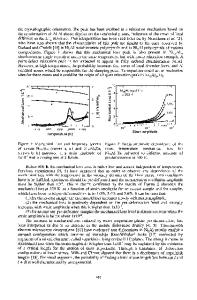The Deformation Microstructure in NI 3 Si Polycrystals Strained Over the Range of Temperature of Flow Stress Anomaly
- PDF / 3,396,219 Bytes
- 6 Pages / 420.48 x 639 pts Page_size
- 23 Downloads / 444 Views
THE DEFORMATION MICROSTRUCTURE IN NI3SI POLYCRYSTALS STRAINED OVER THE RANGE OF TEMPERATURE OF FLOW STRESS ANOMALY B. TOUNSI*, P. BEAUCHAMP*, Y. MISHIMA**, T. SUZUKI** AND P. VEYSSlIRE*** * Laboratoire de Mttallurgie Physique, Facult6 des Sciences, 40 Avenue du Recteur Pineau, 86022 Poitiers. France. ** Research Laboratory of Precision Machinery and Electronics, Tokyo Institute of Technology, Nagatsuta, Midori-Ku, Yokohama 227, Japan. *** LEM, CNRS-ONERA, B.P. 72,92322 Chitillon Cedex. France. ABSTRACT In order to correlate the flow stress anomaly of Ni3Si with dislocation properties, a weakbeam study ofpolycrystalline samples deformed between ambient and the peak temperature was carried out. Samples with two extreme Ni/Si ratios were tested.The most frequently activated slip system changes progressively from octahedral to cubic with increasing temperature. The transformation of superdislocations into Kear-Wilsdorf configurations gives rise to screw dislocations that are rectilinear only after deformation at room temperature. The effect of temperature is to gradually promote bending of Kear-Wisdorf configurations in the cube plane, from a few nanometers at 2300(2 to several tenths of micrometers at intermediate temperature. Cube slip begins to be massively activated a little below the peak temperature. It is suggested that the flow stress anomaly is controlled by progressive exhaustion of octahedral slip by thermally-activated expansion of superdislocations on the cube cross-slip plane. INTRODUCTION Ni3 Si belongs to the wide category of Ll12ordered intermetallic alloys whose flow stress exhibits an anomalous temperature dependence1 .Within this category of alloys, Ni 3Al is by far the most documented system. As in Ni 3AI, the L 2 atomic order in Ni3Si is not thermally affected up to the melting point (T=1040K). Comparison between the dislocation mechanisms that are liable to determine the plasticity of each system is largely facilitated since then it is justified to expect that the physical origin of the anomaly in these alloys is the closest. Referred to its specific behaviour in Ni3Al, the flow stress in polycrystalline Ni3Si peaks at a higher level of stress but at a lower temperature. In both systems the flow stress anomaly is significantly sensitive to a departure from stoichiometry but each one exhibits a specific composition dependence. Typically, the larger the nickel content, the smaller and the larger the strength in Ni3Al and Ni3Si, respectively. From a fundamental standpoint, more important however is the fact that the peak temperature (Td remains stationnary at about 850K in Ni 3AI regardless of composition 2, whereas it ranges between about 370K and 680K in Ni3Si over the domain of L1 2 solid solution, in stoichiometric and Ni-rich Ni3Si, respectively 1 . Assuming that a departure from stoichiometry is liable to affect the respective roles played by the different dislocation processes that give rise to the anomaly, but that the physical nature of these remains the same, comparison between Ni3Si and N
Data Loading...











